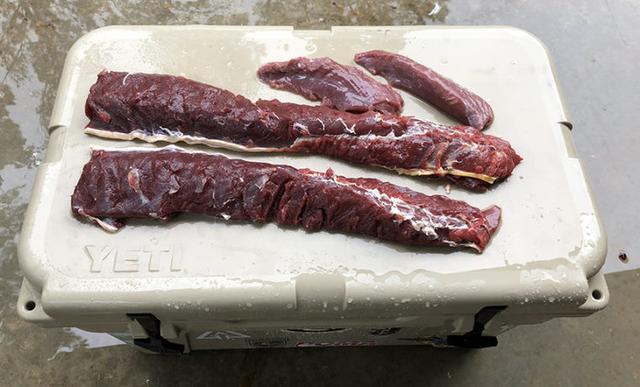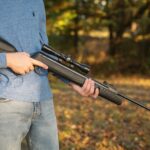Learn the key distinctions between backstrap and tenderloin in deer meat. Discover the nuances in taste, texture, and cooking methods that set these cuts apart. Gain a deeper understanding of these two popular options for maximizing your culinary experience with venison.
Table of Contents
- Understanding the Distinction: Backstrap vs. Tenderloin in Deer Meat
- Exploring the Variances: Backstrap and Tenderloin in Deer Meat
- Demystifying the Cuts: Backstrap vs. Tenderloin in Venison
- Decoding the Terminology: Backstrap and Tenderloin in Deer Meat
- Unveiling the Differences: Backstrap vs. Tenderloin in Venison Cuts
- Differentiating Prime Cuts: Backstrap vs. Tenderloin in Deer Meat
Understanding the Distinction: Backstrap vs. Tenderloin in Deer Meat
Understanding the Distinction: Backstrap vs. Tenderloin in Deer Meat
When it comes to deer meat, there is often confusion between the backstrap and tenderloin cuts. While they are both desirable and delicious, they are not the same thing. The backstrap refers to the large muscles that run parallel along both sides of a deer’s spine and rest on top of the ribcage. On the other hand, the tenderloins are smaller cuts located inside the abdominal cavity underneath the backstrap and spine.
To understand this distinction, think of backstrap as the ribeye in beef and the tenderloins as filet mignon. Both cuts are highly prized for their tenderness, but they differ in size and location within the deer’s body.
To access the tenderloins, you will need to field-dress the deer and remove them from inside the body cavity. They are usually hidden by a layer of fat and lie between the ribs and pelvis. The backstraps, on the other hand, can be easily removed with a sharp fillet knife by making horizontal and vertical cuts along either side of the spine.
The backstraps belong to a group of muscles called Longissimus, which include three sections: Longissimus capitis, Longissimus cervicis, and Longissimus dorsi. The Longissimus dorsi is what we commonly refer to as “backstrap” and is known for its tenderness and flavor. It extends from the shoulder blades all the way down to the lowest vertebrae.
Unlike other muscles in a deer’s body that bear weight constantly, such as shoulders or hindquarters, backstraps are not used for weight-bearing activities. This lack of constant use contributes to their tenderness compared to other cuts.
In terms of cooking and nutrition, backstrap is highly versatile due to its lean nature. It is low in calories and fat, making it a healthy choice. A 3.5-ounce portion of venison backstrap contains only 150 calories and 2.4 grams of fat, compared to beef loin with 205 calories and about 10 grams of fat. Venison is also rich in protein, packing nearly 30 grams per serving.
With its tenderness, lean profile, and versatility in the kitchen, backstrap is a favorite among hunters for good reason. It offers quality nourishment while allowing for various cooking methods and flavors.
In conclusion, understanding the distinction between backstrap and tenderloin in deer meat is essential for both experienced and new hunters. While they are often used interchangeably, they refer to different cuts with distinct characteristics. Backstrap refers to the large muscles along the spine, while tenderloins are smaller cuts located inside the abdominal cavity. Both cuts are highly desirable for their tenderness and flavor, but it’s important to know where they are located on a deer and how to properly remove them for cooking.
Exploring the Variances: Backstrap and Tenderloin in Deer Meat
When it comes to deer meat, two cuts that are often confused are the backstrap and tenderloin. While they are both desirable cuts, they are not the same thing. The backstrap refers to the large muscles that run parallel along both sides of a deer’s spine and rest on top of the ribcage. On the other hand, the tenderloins are smaller cuts located inside the abdominal cavity underneath the backstrap and spine.
To put it in perspective, think of the backstrap as the ribeye in beef and the tenderloins as filet mignon. Both cuts are known for their tenderness, but their names are often used interchangeably.
The tenderloins can be accessed from inside the body cavity after field-dressing the deer. They are usually hidden by a layer of fat and lie underneath the spine between the ribs and pelvis.
The backstrap belongs to a group of muscles called Longissimus, which includes three sections: Longissimus capitis, Longissimus cervicis, and Longissimus dorsi. The Longissimus dorsi is what we commonly refer to as “backstrap” – a thick, tubular, lean muscle that extends from the shoulder blades to the lowest vertebrae.
Unlike other muscles used for weight-bearing like shoulders or hindquarters, backstraps do not constantly bear weight. This lack of constant use makes them more tender compared to other cuts.
To remove the backstrap from a deer carcass, start with a horizontal cut at the junction of the spine and pelvis. Then make a vertical cut down the spine, carefully removing meat from the bone until you reach the base of the neck. Slice along the ribs to delicately trim meat from the ribcage.
Backstrap is highly desired among hunters and cooks due to its tenderness, leanness, and versatility. It is a healthy and nutrient-dense meat, packed with protein and various minerals. A 3.5-ounce portion of venison backstrap contains only 150 calories and 2.4 grams of fat, compared to beef loin’s 205 calories and approximately 10 grams of fat.
With its unique flavor profile and easy cooking methods, backstrap lends itself well to experimentation with different recipes. It is an excellent way to introduce others to the joys of hunting culture and the deliciousness of venison.
The word “venison” derives from the Latin word “venari,” meaning to hunt or pursue. Originally used to describe meat from any game animal killed by hunting, it has evolved over time to specifically refer to members of the deer family.
If you’re interested in expanding your knowledge about deer hunting or getting involved with organizations like the NDA (National Deer Association), there are various opportunities available such as joining local branches, attending banquets or field days, or even helping form new branches.
In conclusion, understanding the variances between backstrap and tenderloin in deer meat is essential for both experienced hunters and newcomers alike. These cuts offer different flavors, textures, and cooking possibilities, making them prized delicacies among hunters and food enthusiasts alike.
Demystifying the Cuts: Backstrap vs. Tenderloin in Venison

When it comes to venison, two cuts that often get confused are the backstrap and the tenderloin. While they may be used interchangeably in conversation, they are not the same thing.
The backstrap refers to the large muscles that run parallel along both sides of a deer’s spine and rest on top of the ribcage. It is a long “strap” of muscle that extends from the shoulder blades all the way down to the lowest vertebrae. In terms of comparison, it is similar to a ribeye in beef.
On the other hand, the tenderloins are smaller cuts located inside the abdominal cavity underneath the backstrap and spine. They lie between the ribs and pelvis and are usually hidden by a layer of fat. Think of them as filet mignon in beef.
To access the tenderloins, you would need to field-dress the deer and remove them from inside the body cavity. They are considered more desirable cuts due to their tenderness.
In terms of taste and texture, both backstrap and tenderloin are prized for their tenderness and lean quality. They are often considered America’s best cuts of meat due to their versatility in cooking methods.
When it comes to nutritional value, venison is a healthier option compared to beef. A 3.5-ounce portion of venison backstrap has fewer calories and less fat than an equivalent portion of beef loin. Venison is also packed with protein and various nutrients such as niacin, iron, potassium, zinc, and B-vitamins.
Removing backstrap from a deer carcass is relatively simple once you have skinned it. The backstrap can be easily separated from the spine by making horizontal and vertical cuts along its length. Carefully trim away any meat from the ribcage to ensure you don’t leave any behind.
In conclusion, while backstrap and tenderloin are both desirable cuts of venison, they are not the same thing. Backstrap refers to the large muscles running along the deer’s spine, while tenderloin is a smaller cut located inside the abdominal cavity. Both cuts offer tenderness and lean quality, making them popular choices among hunters and meat enthusiasts alike.
Decoding the Terminology: Backstrap and Tenderloin in Deer Meat
Decoding the Terminology: Backstrap and Tenderloin in Deer Meat
The backstrap and tenderloin are two highly sought-after cuts of meat in deer hunting. While they are often used interchangeably, it is important to understand that they are not the same thing. The backstrap refers to the large muscles that run parallel along both sides of a deer’s spine and rest on top of the ribcage. It is a long “strap” of muscle that extends from the shoulder blades all the way down to the lowest vertebrae. On the other hand, the tenderloins are smaller cuts located inside the abdominal cavity underneath the backstrap and spine.
To put it into perspective, think of backstrap as the ribeye in beef, while tenderloins can be compared to filet mignon. Both cuts are highly desirable due to their tenderness, but their names are often confused. The tenderloins are usually hidden by a layer of fat and can be accessed from inside the body cavity after field-dressing the deer.
When it comes to removing the backstrap from a deer carcass, it is a fairly simple process. Starting with a horizontal cut at the junction of the spine and pelvis, make a vertical cut down the spine while carefully removing the meat from the bone until you reach the base of the neck. Then, slice along the ribs to delicately trim away any remaining meat from the ribcage.
The reason why backstraps are so tender is because these muscles do not constantly bear weight like shoulders or hindquarters do. The more a muscle is used, such as in weight-bearing activities, the tougher it becomes as muscle fibers break down and rebuild. In comparison, backstraps experience less strain and therefore remain tender.
The backstrap is highly prized among hunters for its tenderness, lean nature, and versatility in cooking. It is considered one of America’s best cuts of meat. Venison, in general, is a healthy and nutrient-dense protein source. A 3.5-ounce portion of venison backstrap contains only 150 calories and 2.4 grams of fat, compared to 205 calories and about 10 grams of fat in the same portion of beef loin. Additionally, venison is packed with essential nutrients and minerals.
In conclusion, understanding the difference between backstrap and tenderloin is important for any deer hunter or enthusiast. While they are both desirable cuts, they have distinct characteristics and locations within the deer’s body. The backstrap is a long muscle running along the spine, while the tenderloins are smaller cuts located underneath the backstrap and spine inside the abdominal cavity. Both cuts offer delicious flavor and tenderness when properly prepared.
Unveiling the Differences: Backstrap vs. Tenderloin in Venison Cuts
The article discusses the differences between backstrap and tenderloin in venison cuts. Backstrap refers to the large muscles that run parallel along both sides of a deer’s spine and rest on top of the ribcage. It is often confused with tenderloin, which is smaller and located inside the abdominal cavity underneath the backstrap and spine.
Backstrap is comparable to ribeye in beef, while tenderloin is similar to filet mignon. The two cuts are desirable due to their tenderness, but their names are often confused. Tenderloins are usually hidden by a layer of fat and can be accessed from inside the body cavity after field-dressing the deer.
The backstrap belongs to a group of muscles called the Longissimus, which includes three sections: Longissimus capitis, Longissimus cervicis, and Longissimus dorsi. The Longissimus dorsi is the longest and largest muscle, extending from the shoulder blades to the lowest vertebrae. This is what is typically referred to as “backstrap.”
Backstraps are tender because they do not constantly bear weight like shoulders or haunches do. The more a muscle is used, the tougher it becomes. Backstraps are easily removed from a deer by making horizontal and vertical cuts along the spine.
Venison backstrap is highly desirable due to its tenderness, leanness, and versatility in cooking. It is considered one of the healthiest and most nutrient-dense meats available, being low in calories and fat while high in protein and various nutrients.
Overall, understanding the differences between backstrap and tenderloin can help hunters properly identify and utilize these prized cuts of venison in their cooking preparations.
Differentiating Prime Cuts: Backstrap vs. Tenderloin in Deer Meat

When it comes to venison, the backstrap and tenderloin are two prime cuts that are highly sought after by hunters. However, there is often confusion about these cuts and their differences.
Firstly, it’s important to understand that backstrap and tenderloin are not the same thing. Backstrap refers to the large muscles that run parallel along both sides of a deer’s spine and rest on top of the ribcage. On the other hand, tenderloins are smaller cuts located inside the abdominal cavity underneath the backstrap and spine.
To put it in perspective, think of backstrap as the ribeye in beef, known for its tenderness and flavor. The tenderloins, on the other hand, can be compared to filet mignon, another highly prized cut due to its tenderness.
The process of removing these cuts from a deer is also different. Backstraps can be easily accessed by making a horizontal cut at the junction of the spine and pelvis, followed by a vertical cut down the spine. Carefully trimming along the ribs allows for the removal of backstraps without leaving any meat behind.
Tenderloins, on the other hand, are located inside the body cavity and can be accessed after field-dressing the deer. They are usually hidden by a layer of fat and require careful removal from inside.
The reason why backstraps and tenderloins are considered desirable cuts is due to their tenderness. Unlike muscles that bear weight constantly like shoulders or haunches, these cuts are not used as extensively by deer and therefore remain more tender.
In terms of nutritional value, venison backstrap is an excellent choice. It is lean with only 2.4 grams of fat per 3.5-ounce portion according to USDA data. It is also a great source of protein, packing nearly 30 grams per serving. Additionally, venison is loaded with nutrients and minerals such as niacin, iron, potassium, zinc, and B-vitamins.
With its tenderness, flavor, and nutritional value, backstrap is a versatile cut that can be cooked in various ways. Whether it’s grilling, pan-searing, or slow-cooking, there are plenty of recipes to explore and enjoy this staple of the hunting culture.
In conclusion, while backstrap and tenderloin are often used interchangeably in hunting camps, they are not the same thing. Backstrap refers to the large muscles along the spine while tenderloins are smaller cuts inside the abdominal cavity. Understanding these differences allows hunters to fully appreciate and utilize these prime cuts in their culinary endeavors.
In summary, the main difference between backstrap and tenderloin in deer meat is their location on the animal. While both cuts are highly prized for their tenderness and flavor, the backstrap is longer and runs along the spine, offering slightly more meat, whereas the tenderloin is smaller and located inside the rib cage. Ultimately, personal preference will determine which cut to choose for a delicious venison dish.










































![Air gun 101: The differences between .177 & .22 – Which jobs they do best ? [Infographic]](https://airgunmaniac.b-cdn.net/wp-content/uploads/2024/11/1773-150x150.jpeg)
